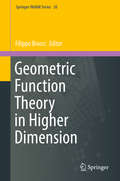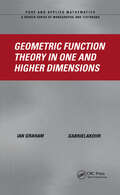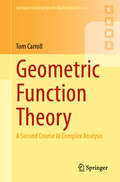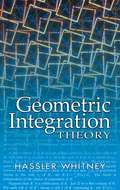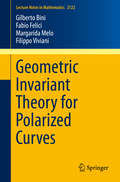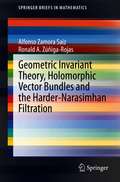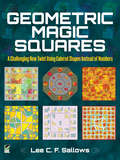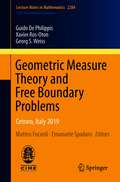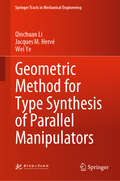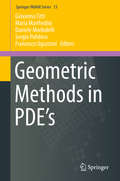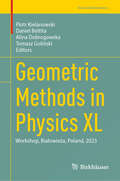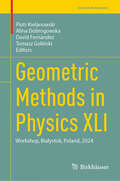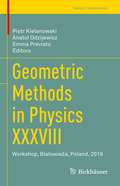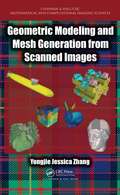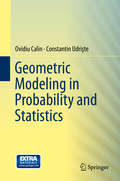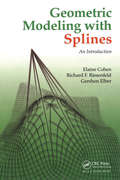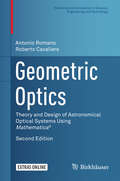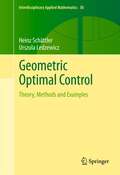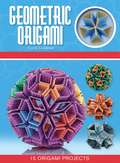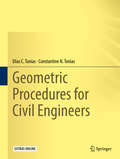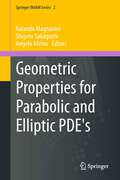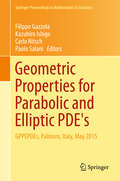- Table View
- List View
Geometric Folding Algorithms
by Joseph O'Rourke Erik D. DemaineDid you know that any straight-line drawing on paper can be folded so that the complete drawing can be cut out with one straight scissors cut? That there is a planar linkage that can trace out any algebraic curve, or even 'sign your name'? Or that a 'Latin cross' unfolding of a cube can be refolded to 23 different convex polyhedra? Over the past decade, there has been a surge of interest in such problems, with applications ranging from robotics to protein folding. With an emphasis on algorithmic or computational aspects, this treatment gives hundreds of results and over 60 unsolved 'open problems' to inspire further research. The authors cover one-dimensional (1D) objects (linkages), 2D objects (paper), and 3D objects (polyhedra). Aimed at advanced undergraduate and graduate students in mathematics or computer science, this lavishly illustrated book will fascinate a broad audience, from school students to researchers.
Geometric Function Theory in Higher Dimension (Springer INdAM #26)
by Filippo BracciThe book collects the most relevant outcomes from the INdAM Workshop “Geometric Function Theory in Higher Dimension” held in Cortona on September 5-9, 2016. The Workshop was mainly devoted to discussions of basic open problems in the area, and this volume follows the same line. In particular, it offers a selection of original contributions on Loewner theory in one and higher dimensions, semigroups theory, iteration theory and related topics. Written by experts in geometric function theory in one and several complex variables, it focuses on new research frontiers in this area and on challenging open problems. The book is intended for graduate students and researchers working in complex analysis, several complex variables and geometric function theory.
Geometric Function Theory in One and Higher Dimensions
by Ian Graham Gabriela KohrThis reference details valuable results that lead to improvements in existence theorems for the Loewner differential equation in higher dimensions, discusses the compactness of the analog of the Caratheodory class in several variables, and studies various classes of univalent mappings according to their geometrical definitions. It introduces the in
Geometric Function Theory: A Second Course in Complex Analysis (Springer Undergraduate Mathematics Series)
by Tom CarrollThis textbook provides a second course in complex analysis with a focus on geometric aspects. It covers topics such as the spherical geometry of the extended complex plane, the hyperbolic geometry of the Poincaré disk, conformal mappings, the Riemann Mapping Theorem and uniformisation of planar domains, characterisations of simply connected domains, the convergence of Riemann maps in terms of Carathéodory convergence of the image domains, normal families and Picard's theorems on value distribution, as well as the fundamentals of univalent function theory. Throughout the text, the synergy between analysis and geometry is emphasised, with proofs chosen for their directness. The textbook is self-contained, requiring only a first undergraduate course in complex analysis. The minimal topology needed is introduced as necessary. While primarily aimed at upper-level undergraduates, the book also serves as a concise reference for graduates working in complex analysis.
Geometric Integration Theory
by Hassler WhitneyGeared toward upper-level undergraduates and graduate students, this treatment of geometric integration theory consists of three parts: an introduction to classical theory, a postulational approach to general theory, and a final section that continues the general study with Lebesgue theory.The introductory chapter shows how the simplest hypotheses lead to the employment of basic tools. The opening third of the treatment, an examination of classical theory, leads to the theory of the Riemann integral and includes a study of smooth (i.e., differentiable) manifolds. The second part, on general theory, explores abstract integration theory, some relations between chains and functions, general properties of chains and cochains, and chains and cochains in open sets. The third and final section surveys Lebesgue theory in terms of flat cochains and differential forms, Lipschitz mappings, and chains and additive set functions. Appendixes on vector and linear spaces, geometric and topological preliminaries, and analytical preliminaries, along with indexes of symbols and terms, conclude the text.
Geometric Invariant Theory for Polarized Curves
by Filippo Viviani Gilberto Bini Fabio Felici Margarida MeloWe investigate GIT quotients of polarized curves. More specifically, we study the GIT problem for the Hilbert and Chow schemes of curves of degree d and genus g in a projective space of dimension d-g, as d decreases with respect to g. We prove that the first three values of d at which the GIT quotients change are given by d=a(2g-2) where a=2, 3. 5, 4. We show that, for a>4, L. Caporaso's results hold true for both Hilbert and Chow semistability. If 3. 5
Geometric Invariant Theory, Holomorphic Vector Bundles and the Harder-Narasimhan Filtration (SpringerBriefs in Mathematics)
by Alfonso Zamora Saiz Ronald A. Zúñiga-RojasThis book introduces key topics on Geometric Invariant Theory, a technique to obtaining quotients in algebraic geometry with a good set of properties, through various examples. It starts from the classical Hilbert classification of binary forms, advancing to the construction of the moduli space of semistable holomorphic vector bundles, and to Hitchin’s theory on Higgs bundles. The relationship between the notion of stability between algebraic, differential and symplectic geometry settings is also covered.Unstable objects in moduli problems -- a result of the construction of moduli spaces -- get specific attention in this work. The notion of the Harder-Narasimhan filtration as a tool to handle them, and its relationship with GIT quotients, provide instigating new calculations in several problems. Applications include a survey of research results on correspondences between Harder-Narasimhan filtrations with the GIT picture and stratifications of the moduli space of Higgs bundles.Graduate students and researchers who want to approach Geometric Invariant Theory in moduli constructions can greatly benefit from this reading, whose key prerequisites are general courses on algebraic geometry and differential geometry.
Geometric Magic Squares: A Challenging New Twist Using Colored Shapes Instead of Numbers (Dover Recreational Math)
by Lee C.F. SallowsTraditional magic squares employ a chessboard-like arrangement of numbers in which the total of all rows, columns, and diagonals add up to the same number. This innovative approach by a British engineer shines a new light on the centuries-old amusement, challenging puzzlists to think two dimensionally in solving dozens of creative puzzles with vivid geometric shapes instead of numbers. Attempt The Twelve Pentominoes, a challenge consisting of the formation of a dozen different shapes from five-unit squares. Squeeze together the 16 pieces of a 4 x 4 self-interlocking square to form an empty 4 x 4 array. Take aim at 48 targets featuring astrological signs in a self-interlocking square. Suitable for puzzle lovers ages 12 and up, these and other colorful variations on conventional magic squares offer hours of captivating entertainment.
Geometric Measure Theory and Free Boundary Problems: Cetraro, Italy 2019 (Lecture Notes in Mathematics #2284)
by Guido De Philippis Xavier Ros-Oton Georg S. WeissThis volume covers contemporary aspects of geometric measure theory with a focus on applications to partial differential equations, free boundary problems and water waves. It is based on lectures given at the 2019 CIME summer school “Geometric Measure Theory and Applications – From Geometric Analysis to Free Boundary Problems” which took place in Cetraro, Italy, under the scientific direction of Matteo Focardi and Emanuele Spadaro. Providing a description of the structure of measures satisfying certain differential constraints, and covering regularity theory for Bernoulli type free boundary problems and water waves as well as regularity theory for the obstacle problems and the developments leading to applications to the Stefan problem, this volume will be of interest to students and researchers in mathematical analysis and its applications.
Geometric Method for Type Synthesis of Parallel Manipulators (Springer Tracts in Mechanical Engineering)
by Qinchuan Li Jacques M. Hervé Wei YeThis book focuses on the synthesis of lower-mobility parallel manipulators, presenting a group-theory-based method that has the advantage of being geometrically intrinsic. Rotations and translations of a rigid body as well as a combination of the two can be expressed and handled elegantly using the group algebraic structure of the set of rigid-body displacements. The book gathers the authors’ research results, which were previously scattered in various journals and conference proceedings, presenting them in a unified form. Using the presented method, it reveals numerous novel architectures of lower-mobility parallel manipulators, which are of interest to those in the robotics community. More importantly, readers can use the method and tool to develop new types of lower-mobility parallel manipulators independently.
Geometric Methods in PDE's
by Giovanna Citti Maria Manfredini Daniele Morbidelli Sergio Polidoro Francesco UguzzoniThe analysis of PDEs is a prominent discipline in mathematics research, both in terms of its theoretical aspects and its relevance in applications. In recent years, the geometric properties of linear and nonlinear second order PDEs of elliptic and parabolic type have been extensively studied by many outstanding researchers. This book collects contributions from a selected group of leading experts who took part in the INdAM meeting "Geometric methods in PDEs", on the occasion of the 70th birthday of Ermanno Lanconelli. They describe a number of new achievements and/or the state of the art in their discipline of research, providing readers an overview of recent progress and future research trends in PDEs. In particular, the volume collects significant results for sub-elliptic equations, potential theory and diffusion equations, with an emphasis on comparing different methodologies and on their implications for theory and applications.
Geometric Methods in Physics XL: Workshop, Białowieża, Poland, 2023 (Trends in Mathematics)
by Piotr Kielanowski Daniel Beltita Alina Dobrogowska Tomasz GolińskiThis volume collects papers based on lectures given at the XL Workshop on Geometric Methods in Physics, held in Białowieża, Poland in July 2023. These chapters provide readers an overview of cutting-edge research in infinite-dimensional groups, integrable systems, quantum groups, Lie algebras and their generalizations and a wide variety of other areas. Specific topics include: Yang-Baxter equation The restricted Siegel disc and restricted Grassmannian Geometric and deformation quantization Degenerate integrability Lie algebroids and groupoids Skew braces Geometric Methods in Physics XL will be a valuable resource for mathematicians and physicists interested in recent developments at the intersection of these areas.
Geometric Methods in Physics XLI: Workshop, Białystok, Poland, 2024 (Trends in Mathematics)
by Piotr Kielanowski Alina Dobrogowska Tomasz Goliński David FernándezThis volume collects papers based on lectures given at the XLI Workshop on Geometric Methods in Physics, held in Białystok, Poland in July 2024 as well as extended abstracts of minicourses presented during the XIII School on Geometry and Physics. These chapters provide readers an overview of cutting-edge research in quantum field theories, infinite-dimensional groups, integrable systems, noncommutative geometry, and a wide variety of other areas. Specific topics include:• Graded structures• Lie algebra structures• Quasicrystals• Sigma models• Barycentric algebras• Nijenhuis geometryGeometric Methods in Physics XLI will be a valuable resource for mathematicians and physicists interested in recent developments at the intersection of these areas.
Geometric Methods in Physics XXXVIII: Workshop, Białowieża, Poland, 2019 (Trends in Mathematics)
by Piotr Kielanowski Anatol Odzijewicz Emma PreviatoThe book consists of articles based on the XXXVIII Białowieża Workshop on Geometric Methods in Physics, 2019. The series of Białowieża workshops, attended by a community of experts at the crossroads of mathematics and physics, is a major annual event in the field. The works in this book, based on presentations given at the workshop, are previously unpublished, at the cutting edge of current research, typically grounded in geometry and analysis, with applications to classical and quantum physics.For the past eight years, the Białowieża Workshops have been complemented by a School on Geometry and Physics, comprising series of advanced lectures for graduate students and early-career researchers. The extended abstracts of the five lecture series that were given in the eighth school are included. The unique character of the Workshop-and-School series draws on the venue, a famous historical, cultural and environmental site in the Białowieża forest, a UNESCO World Heritage Centre in the east of Poland: lectures are given in the Nature and Forest Museum and local traditions are interwoven with the scientific activities.
Geometric Methods in Signal and Image Analysis
by Hamid Krim A. Ben HamzaThis comprehensive guide offers a new approach for developing and implementing robust computational methodologies that uncover the key geometric and topological information from signals and images. With the help of detailed real-world examples and applications, readers will learn how to solve complex signal and image processing problems in fields ranging from remote sensing to medical imaging, bioinformatics, robotics, security, and defence. With an emphasis on intuitive and application-driven arguments, this text covers not only a range of methods in use today, but also introduces promising new developments for the future, bringing the reader up-to-date with the state of the art in signal and image analysis. Covering basic principles as well as advanced concepts and applications, and with examples and homework exercises, this is an invaluable resource for graduate students, researchers, and industry practitioners in a range of fields including signal and image processing, biomedical engineering, and computer graphics.
Geometric Modeling and Mesh Generation from Scanned Images (Chapman & Hall/CRC Mathematical and Computational Imaging Sciences Series #6)
by Yongjie Jessica ZhangCutting-Edge Techniques to Better Analyze and Predict Complex Physical Phenomena Geometric Modeling and Mesh Generation from Scanned Images shows how to integrate image processing, geometric modeling, and mesh generation with the finite element method (FEM) to solve problems in computational biology, medicine, materials science, and engineering. Based on the author’s recent research and course at Carnegie Mellon University, the text explains the fundamentals of medical imaging, image processing, computational geometry, mesh generation, visualization, and finite element analysis. It also explores novel and advanced applications in computational biology, medicine, materials science, and other engineering areas. One of the first to cover this emerging interdisciplinary field, the book addresses biomedical/material imaging, image processing, geometric modeling and visualization, FEM, and biomedical and engineering applications. It introduces image-mesh-simulation pipelines, reviews numerical methods used in various modules of the pipelines, and discusses several scanning techniques, including ones to probe polycrystalline materials. The book next presents the fundamentals of geometric modeling and computer graphics, geometric objects and transformations, and curves and surfaces as well as two isocontouring methods: marching cubes and dual contouring. It then describes various triangular/tetrahedral and quadrilateral/hexahedral mesh generation techniques. The book also discusses volumetric T-spline modeling for isogeometric analysis (IGA) and introduces some new developments of FEM in recent years with applications.
Geometric Modeling in Probability and Statistics
by Ovidiu Calin Constantin UdrişteThis book covers topics of Informational Geometry, a field which deals with the differential geometric study of the manifold probability density functions. This is a field that is increasingly attracting the interest of researchers from many different areas of science, including mathematics, statistics, geometry, computer science, signal processing, physics and neuroscience. It is the authors' hope that the present book will be a valuable reference for researchers and graduate students in one of the aforementioned fields. This textbook is a unified presentation of differential geometry and probability theory, and constitutes a text for a course directed at graduate or advanced undergraduate students interested in applications of differential geometry in probability and statistics. The book contains over 100 proposed exercises meant to help students deepen their understanding, and it is accompanied by software that is able to provide numerical computations of several information geometric objects. The reader will understand a flourishing field of mathematics in which very few books have been written so far.
Geometric Modeling with Splines: An Introduction
by Elaine Cohen Richard F. Riesenfeld Gershon ElberWritten by researchers who have helped found and shape the field, this book is a definitive introduction to geometric modeling. The authors present all of the necessary techniques for curve and surface representations in computer-aided modeling with a focus on how the techniques are used in design.
Geometric Optics
by Antonio Romano Roberto CavaliereThis book--unique in the literature--provides readers with the mathematical background needed to design many of the optical combinations that are used in astronomical telescopes and cameras. The results presented in the work were obtained by using a different approach to third-order aberration theory as well as the extensive use of the software package Mathematica®. Replete with workout examples and exercises, Geometric Optics is an excellent reference for advanced graduate students, researchers, and practitioners in applied mathematics, engineering, astronomy, and astronomical optics. The work may be used as a supplementary textbook for graduate-level courses in astronomical optics, optical design, optical engineering, programming with Mathematica, or geometric optics.
Geometric Optimal Control
by Urszula Ledzewicz Heinz SchättlerThis book gives a comprehensive treatment of the fundamental necessary and sufficient conditions for optimality for finite-dimensional, deterministic, optimal control problems. The emphasis is on the geometric aspects of the theory and on illustrating how these methods can be used to solve optimal control problems. It provides tools and techniques that go well beyond standard procedures and can be used to obtain a full understanding of the global structure of solutions for the underlying problem. The text includes a large number and variety of fully worked out examples that range from the classical problem of minimum surfaces of revolution to cancer treatment for novel therapy approaches. All these examples, in one way or the other, illustrate the power of geometric techniques and methods. The versatile text contains material on different levels ranging from the introductory and elementary to the advanced. Parts of the text can be viewed as a comprehensive textbook for both advanced undergraduate and all level graduate courses on optimal control in both mathematics and engineering departments. The text moves smoothly from the more introductory topics to those parts that are in a monograph style were advanced topics are presented. While the presentation is mathematically rigorous, it is carried out in a tutorial style that makes the text accessible to a wide audience of researchers and students from various fields, including the mathematical sciences and engineering. Heinz Schättler is an Associate Professor at Washington University in St. Louis in the Department of Electrical and Systems Engineering, Urszula Ledzewicz is a Distinguished Research Professor at Southern Illinois University Edwardsville in the Department of Mathematics and Statistics.
Geometric Origami (Origami Books)
by Faye GoldmanToo hip to be square, Geometric Origami takes the art of paper folding to stunning new heights.A sophisticated new origami kit for advanced paper-folding enthusiasts, Geometric Origami takes paper art to spectacular new levels. Fifteen intricate paper projects use specially designed strips that come with the book and include a tetrahedron, hexahedron, octahedron, dodecahedron, icosahedron, truncated tetrahedron, cuboctahedron, icosidodecahedron, rhombic triacontahedron, snub dodecahedron, zonohedron, and buckyballs. And don't worry - there are even a few pronounceable shapes like the egg and a geometric bracelet, plus more surprises. This beautifully designed kit gives a new perspective on geometry and the world of origami and is great fun for the entire family - or the perfect gift for a math professor.
Geometric Partial Differential Equations and Image Analysis
by Guillermo SapiroThis book provides an introduction to the use of geometric partial differential equations in image processing and computer vision. It brings a number of new concepts into the field, providing a very fundamental and formal approach to image processing. State-of-the-art practical results in a large number of real problems are achieved with the techniques described. Applications covered include image segmentation, shape analysis, image enhancement, and tracking. The volume provides information for people investigating new solutions to image processing problems as well as for people searching for existent advanced solutions.
Geometric Procedures for Civil Engineers
by Elias C. Tonias Constantine N. ToniasThis book provides a multitude of geometric constructions usually encountered in civil engineering and surveying practice. A detailed geometric solution is provided to each construction as well as a step-by-step set of programming instructions for incorporation into a computing system. The volume is comprised of 12 chapters and appendices that may be grouped in three major parts: the first is intended for those who love geometry for its own sake and its evolution through the ages, in general, and, more specifically, with the introduction of the computer. The second section addresses geometric features used in the book and provides support procedures used by the constructions presented. The remaining chapters and the appendices contain the various constructions. The volume is ideal for engineering practitioners in civil and construction engineering and allied areas.
Geometric Properties for Parabolic and Elliptic PDE's
by Angelo Alvino Rolando Magnanini Shigeru SakaguchiThe study of qualitative aspects of PDE's has always attracted much attention from the early beginnings. More recently, once basic issues about PDE's, such as existence, uniqueness and stability of solutions, have been understood quite well, research on topological and/or geometric properties of their solutions has become more intense. The study of these issues is attracting the interest of an increasing number of researchers and is now a broad and well-established research area, with contributions that often come from experts from disparate areas of mathematics, such as differential and convex geometry, functional analysis, calculus of variations, mathematical physics, to name a few. This volume collects a selection of original results and informative surveys by a group of international specialists in the field, analyzes new trends and techniques and aims at promoting scientific collaboration and stimulating future developments and perspectives in this very active area of research.
Geometric Properties for Parabolic and Elliptic PDE's
by Filippo Gazzola Kazuhiro Ishige Carlo Nitsch Paolo SalaniThis book collects recent research papers by respected specialists in the field. It presents advances in the field of geometric properties for parabolic and elliptic partial differential equations, an area that has always attracted great attention. It settles the basic issues (existence, uniqueness, stability and regularity of solutions of initial/boundary value problems) before focusing on the topological and/or geometric aspects. These topics interact with many other areas of research and rely on a wide range of mathematical tools and techniques, both analytic and geometric. The Italian and Japanese mathematical schools have a long history of research on PDEs and have numerous active groups collaborating in the study of the geometric properties of their solutions.

